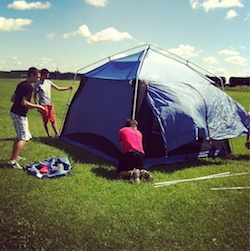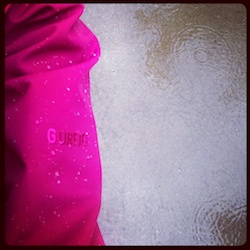Friday, May 3, 2013 - Blog on a Log
How to Clean and Repair your Gear for Spring
How should I prepare for the spring camping season?
With spring weather finally on its way we're all excited to get out and enjoy the great weather. Before you get too ahead of yourself, it's a good idea to check your gear over to make sure it's up to the challenge. With regular maintenance, outdoor gear can keep performing at a high level for years to come.
1: Set up and air out your gear
Take an opportunity to pull out all the gear and clothing that's been stored away for the winter months. This gives packed away items the chance to shake off any musty smell, and is the perfect opportunity to remind yourself of any repairs that weren't completed last year.
 Set up your tent
Set up your tent
No one wants to arrive for the first camping trip of the season only to remember the pole that broke at the end of last fall! Set up your tent in a yard or large room and check it over for any rips or damage. Count the tent pegs and make sure none are missing. If possible, leave the tent standing for a day to allow it the chance to air out.
Fluff out your sleeping bag
It is best to store sleeping bags hanging so their insulation does not become compressed. However if your bag has been packed down, now is the perfect time to take it out and regain some of the loft. Shake the bag out and allow it to rest somewhere where it will not get crushed. If your bag has become particularly compacted, running it through an 'air fluff' dryer setting with no heat can also help regain loft.
2: Clean and re-finish your gear
As you are setting up and airing out your gear, you may notice some dirt or unpleasant smells left over from last season. Be careful not to use regular detergents on technical gear - most sleeping bags, tents and jackets require special washing to maintain their technical qualities.
How to Wash Sleeping Bags
Many bags simply require a day of airing to remove any musty smells. However if things are getting particularly funky, it may be time for a full wash. DO NOT use regular detergents on sleeping bags. Detergents coats the insulating fibers (both down and synthetic) causing them to clump together and loose their loft. Always use a down wash on down-filled bags and a tech wash on synthetic bags to maintain your bag's warmth.
 How to Wash Rain Jackets
How to Wash Rain Jackets
Waterproof breathable rainwear only works when water vapour can escape out through the garment's pores. When these pores become clogged with dirt, dust and skin oils they lose their breathability. Regular detergents can leave deposits that get trapped in these pores, making the problem even worse. To regain your rainwear's breathable properties, wash items with tech wash to clear out the pores.
If your rain gear has begun to loose its water repellancy, it may require refinishing. After first cleaning it, use a waterproofing treatment to improve repellancy.
How to Clean a Camp Stove
A clean stove produces a cleaner and hotter flame, allowing you to cook meals more efficiently and conserve fuel. White gas burns cleaner than most fuels, and requires less maintenance, but even white gas stoves can benefit from regular maintenance. While still at home, take off any removable parts to your stove and clean all areas with dish soap and warm water. Leave to dry overnight, reassemble, and oil all moving parts (such as the fuel pump). Test your stove outdoors in a safe area with no wind.
If your stove is clogged, disassembling may be necessary to clean any stuck parts. Specific disassembly instructions will vary by stove, but may be available from the manufacturer or by visiting us in store.
How to Clean Tents, Backpacks, Thermarests, and other Large Items
For items too large to fit in a washing machine, spot clean any dirty areas with tech wash and a soft cloth. Waterproof items too big for the washing machine (like some rain flys) can be refinished using a spray-on treatment.
3. Repair your Gear
Cleaning your gear before each season gives you a great opportunity to search for any repairs that need to be made. Most small repairs can be made yourself without having to purchase entirely new gear.
Waterproof Patches
Patches can be used to fix rips or tears in waterproof materials. Though not a permanent fix, these are great to take with you as a temporary solution, and in a pinch can extend the life of your gear for some time.
Seam Sealer
Aquaseal provides a flexible, permanent seal perfect for reenforceing leaky tent seams. It's also the industry standard choice for repairs on wetsuits, dry suits, or any items used in or around the water.
Air Mattress Repair
Leaky air mattresses can be made as good as new with a basic Thermarest repair kit. The kit allows for fast and permanent repairs to any air mattress, and is easy enough to use right in the field.
Regular maintenance will make your gear will last longer and better so you can keep chasing your adventures in comfort.







